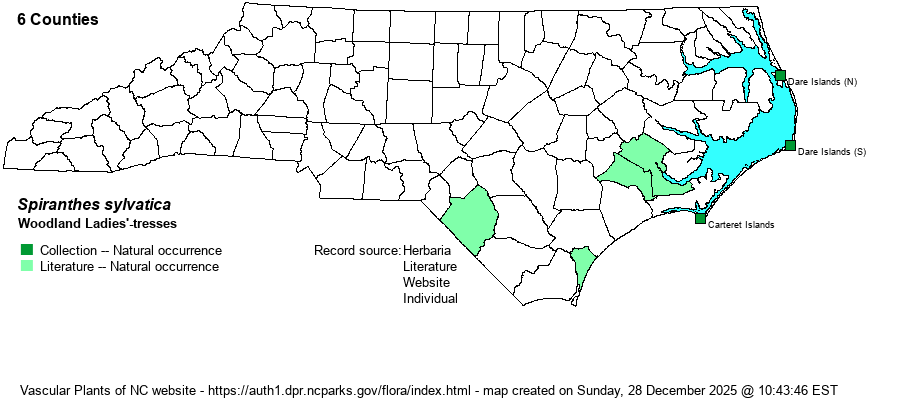| Section 5 » Family Orchidaceae |
Show/Hide Synonym
| taxonName | relationship | relatedTaxonName | relatedTaxonRefText | relComments |
|---|
|
|
|
| Spiranthes sylvatica | < | Spiranthes praecox | Gleason and Cronquist (1991) | | | Spiranthes sylvatica | < | Spiranthes praecox | Fernald (1950) | | | Spiranthes sylvatica | < | Spiranthes praecox | Flora of North America (1993b, 1997, 2000, 2002a, 2002b, 2003a, 2004b, 2005, 2006a, 2006b, 2006c, 2007a, 2009, 2010) | | | Spiranthes sylvatica | < | Spiranthes praecox | Gleason (1952) | | | Spiranthes sylvatica | < | Spiranthes praecox | Godfrey and Wooten (1979, 1981) | | | Spiranthes sylvatica | < | Spiranthes praecox | Kartesz (1999) | | | Spiranthes sylvatica | < | Spiranthes praecox | | | | Spiranthes sylvatica | < | Spiranthes praecox | Radford, Ahles, and Bell (1968) | | | Spiranthes sylvatica | < | Spiranthes praecox | Correll (1950)=X. [also see Sacoila] | | | Spiranthes sylvatica | < | Ibidium praecox | Small (1933, 1938) | | | Source: Weakley's Flora |
|
| Author | P.M. Brown | |
| Distribution | This is a recently described species (2002), split off from Spiranthes praecox. There are very few specimens known from NC, and it is likely that there might be others lurking in various herbaria still under the name of S. praecox that have not been examined. At any rate, it seems to be limited to the Coastal Plain, mainly along the barrier islands.
The BONAP map shows it only from extreme southern GA south into central FL, but Weakley (2024) gives its range from "VA south to c. peninsular FL". As there are a few specimens for NC, the BONAP map is certainly incomplete. | |
| Abundance | Weakley (2024) shows it as "rare" in the NC Coastal Plain on his map, and the website editors have only uncovered specimens from about three localities so far. Photos on iNaturalist have documented the species from an additional three counties. For now it is considered as "rare" in the state, with a State Rank of S1?. It was added to the Watch List in 2024. The population at Theodore Roosevelt Natural Area (Carteret County) contains hundreds of plants. | |
| Habitat | Weakley's (2024) habitat listings of "Pine-oak forests and woodlands, live oak hammocks, interdune swales, rich dry forests, other woodlands" implies it is a plant mainly of upland wooded or semi-wooded habitats near the coast. The North American Orchid Conservation Center website states that it is "found growing in shaded habitats with dry soils such as roadsides, open woodlands, and live oak hammocks". Most of the relatively few NC specimens have been collected in moist to mesic maritime forests on barrier islands. Photos considered of Research Grade on iNaturalist are also from forest interiors near the coast. | |
| Phenology | Blooms from late March into June, and fruits shortly after flowering. | |
| Identification | Because this is a split from S. praecox, this "new" species looks quite similar to that rather numerous and widespread species. S. sylvatica differs in its very pale green to creamy-colored flowers (but still "whitish") and its habit of growing mostly in dry to mesic forested soils, and not in strongly wetland sites such as marshes, ditches, wet savannas, and open swamps (where S. praecox grows). Also, S. sylvatica has flowers 10-17 mm (close to about 1/2-inch) long, as opposed to S. praecox flowers being 6-9 mm (around 1/3-inch) long. Note that both of these species have the green lines/veins on the top of the lip, which should rule out essentially all other Spiranthes species from consideration. Though it is tentatively called "rare", the fact that it has been recorded inland to Robeson County and as far north as Dare County, certainly it should be found in other Coastal Plain counties between these. In fact, as mentioned in Distribution, how many specimens labeled as S. praecox are really S. sylvatica? | |
| Taxonomic Comments | This is a rather recently described species. It never seems to have been listed as a variety of S. praecox, but was simply subsumed within it and overlooked as that widespread species.
| |
| Other Common Name(s) | Pale-green Ladies'-tresses | |
| State Rank | S1? | |
| Global Rank | GNR | |
| State Status | W7 | |
| US Status | | |
| USACE-agcp | | |
| USACE-emp | | |

